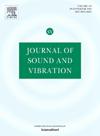Rotor/stator interaction noise prediction in C-shaped duct with lifting surface method
IF 4.3
2区 工程技术
Q1 ACOUSTICS
引用次数: 0
Abstract
To comply with the rigorous constraints imposed on nacelle length in Ultra-High Bypass Ratio (UHBR) engines, bifurcations that were conventionally positioned downstream of the fan stage are integrated into the outlet guide vanes (OGVs). Consequently, the rearward fan noise is strongly affected by the bifurcations, as the azimuthal uniformity of OGV is disrupted and the aft-fan duct is partitioned into two C-shaped ducts. This impact is investigated using lifting surface method, assuming that the duct is infinitely long with a constant C-shaped cross-section, and the flow is uniform neglecting the distortion caused by bifurcations. Through the incorporation of a tailored Green’s function, the bifurcations are modeled as sound reflection boundaries. Subsequently, the unsteady loading on the vanes and the rearward sound power are calculated and compared against those in the annular duct. Analysis reveals that multiple azimuthal modes are scattered, resulting in a hump-shaped mode distribution. The radial mode distribution is found to be intimately related to the radial obliquity of rotor wake. The unsteady loading on different vanes shows diverse yet similar distribution after reducing the difference in the inter-blade phase angle (IBPA). These findings should contribute to the noise prediction and acoustic design of UHBR fan featured by integrated OGV and C-shaped aft-fan duct.
用升力面法预测c型风管动静噪声
为了满足超高涵道比(UHBR)发动机对机舱长度的严格限制,传统上位于风扇级下游的分支被整合到出口导叶(ogv)中。因此,由于支板的方位均匀性被破坏,后扇风道被分割成两个c形风道,后扇噪声受到分支的强烈影响。采用升力面法研究了这种影响,假设风管是无限长且具有恒定的c形截面,并且忽略分岔引起的畸变,流动均匀。通过结合定制的格林函数,分岔被建模为声反射边界。随后,计算了叶片上的非定常载荷和后向声功率,并与环形风道内的非定常载荷和后向声功率进行了比较。分析表明,多个方位角模分布分散,导致模态呈驼峰状分布。径向模态分布与旋翼尾迹的径向倾角密切相关。在减小叶片间相位角(IBPA)差异后,不同叶片上的非定常载荷呈现出既不同又相似的分布。这些研究结果将为集成支板和c型后风道的UHBR风机的噪声预测和声学设计提供参考。
本文章由计算机程序翻译,如有差异,请以英文原文为准。
求助全文
约1分钟内获得全文
求助全文
来源期刊

Journal of Sound and Vibration
工程技术-工程:机械
CiteScore
9.10
自引率
10.60%
发文量
551
审稿时长
69 days
期刊介绍:
The Journal of Sound and Vibration (JSV) is an independent journal devoted to the prompt publication of original papers, both theoretical and experimental, that provide new information on any aspect of sound or vibration. There is an emphasis on fundamental work that has potential for practical application.
JSV was founded and operates on the premise that the subject of sound and vibration requires a journal that publishes papers of a high technical standard across the various subdisciplines, thus facilitating awareness of techniques and discoveries in one area that may be applicable in others.
 求助内容:
求助内容: 应助结果提醒方式:
应助结果提醒方式:


